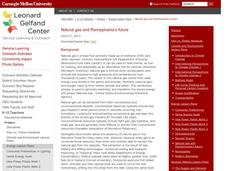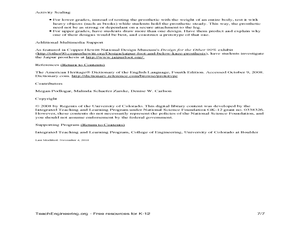Curated OER
The Mystery of the Sponge
First graders observe while water is absorbed into a sponge. They experiment by putting a sponge on yardstick and watch while water dries and the weight changes.
Carnegie Mellon University
Natural Gas and Pennsylvania’s Future
Beginning with a general discussion about natural gas, methane, and hydrocarbons, a few videos and diagrams are projected to support the lecture. Individuals participate in a brief activity by drinking juice through a straw, and then...
Curated OER
Nailing Rust
When your upper elementary or middle school class is learning about chemical changes, these activities help demonstrate the concepts. In Part A, they submerge and place a nail partially underwater, then after a week they make...
Ocean Explorer
Architects of the Coral Reef
Coral Reefs are the focus of a life science lesson plan. Upper graders look at how coral reefs are formed, how the animals and plants reproduce, and the variety of ways that humans benefit from coral reefs around the world. Groups of...
Utah LessonPlans
The Mystery of the Sponge
Students observe that water has weight and that weight decreases as water evaporates. The changes that occur as a sponge dries on a yardstick balance illustrates this concept.
Curated OER
The Giant Barrel Sponge
Students study barrel sponges. In this science and art lesson, students discuss what sponges are, create their own sponge, and share what they created with the rest of the class.
Curated OER
Making Sense of Our Senses
Students participate in activities about the five senses. They explore objects, listen to stories and discuss the senses with classmates.
Curated OER
Saving Sponge Bob Square Pants
Students apply the use of technology to real life scenarios. In this technology lesson, students discuss and identify a method to move sponge bob from one location to the next, without touching the floor. They share the same landmark and...
NOAA
Importance of Deep-Sea Ecosystems – Chemists with No Backbones
Marine invertebrates offer us many new options for developing pharmaceutical drugs, such as w-conotoxin MVIIA, which is extracted from the cone snail and is a potent painkiller. The lesson encourages scholars to research various types of...
Curated OER
Introducing Essential Questions
If you are introducing procedures to your class, then this sequence of instructions will be useful. Students are given a specific set of directions, and are allotted a specific amount of time in which to finish them. The instructions on...
Curated OER
Dripping Wet or Dry as a Bone?
Students use a sponge and water model to explore the concept of relative humidity and create a percent scale. They define humidity and saturation, build a simple humidity/saturation model, collect, predict and interpret data, and create...
Curated OER
Prosthetic Party
Students examine human anatomy by creating a prosthetic limb. In this medical engineering lesson, students view numerous images of prosthetics used in science today and define several medical terms associated with prosthetics. Students...
Curated OER
The Benthic Drugstore
Students examine active chemicals that are in marine invertebrates and how they act to fight diseases. In this marine lesson students identify three pharmacologically-active chemicals, describe their disease fighting action and infer...
Teach Engineering
Bridge Types: Tensile and Compressive Forces
Bridges rely on tension and compression to keep them standing. Pairs test this principle by constructing simple bridges and applying a force to the center. Teams use the provided instructional activity to record their observations of the...
Teach Engineering
The Amazing Aerogel
Introducing ... the aerogel. The first of a two-installment series teaches young engineers about the properties and uses of aerogels. A PowerPoint presentation provides information about this unique material to help solidify the concept.
Columbus City Schools
Heredity: Traits, Genes, Alleles
If you knew people would pay extra for a bald dragon, could you pick which parents you should breed in order to get the highest number? The unit examines heredity and genetics through breeding dragons, mice, dogs, and tries to figure...
New South Wales Department of Education
Invertebrates
Of all invertebrates, insects by far are the most numerous. Scholars discuss invertebrates and then use a key to classify them. They see different examples and must describe features of each organism based upon the key.
Curated OER
Weather
Fifth graders study the water cycle. In this science lesson plan, 5th graders distinguish among evaporation, condensation, and precipitation phases of the water cycle.
Curated OER
Sinkholes in a Cup
Young scholars create sinkholes and learn about the formation of sinkholes by using water, a foam cup, sugar, sand, and a sponge. In this sinkholes lesson plan, students also answer short answer questions.
Curated OER
New Jersey Estuaries Water Filter Activity
Students examine how an estuary's plants and soil filter water before it flows into the ocean. They complete a lab report drawing and writing about what they observe after completing a water filter activity.
Curated OER
Desert Adaptations
In this desert adaptations worksheet, students are given a water filled sponge which represents an animal. Students observe their "animal" for a 24 hour period and conserve the water in the sponge as best they can. They measure and...
Curated OER
How Does Your Garden Grow?
Learners examine birdseed to see if it is a fertilized seed. In this birdseed garden lesson plan, students experiment with birdseed on a sponge to see what grows. Learners record the growth of seeds.
Curated OER
Salt Marsh in a Pan
Students create a model of a salt marsh to discover the impact of pollution and human activities on water-based habitats including bays and the ocean. They recognize the relationship between natural and developed areas. Students impact...
Curated OER
What is a Cloud?
Students identify what clouds are made of. In this weather science lesson, students look at clouds outside the window and draw what they see in their journals. Students read the book It Looked Like Spilled Milk and identify what clouds...

























